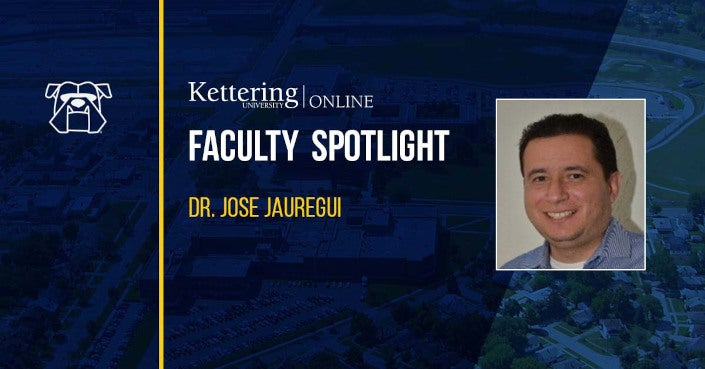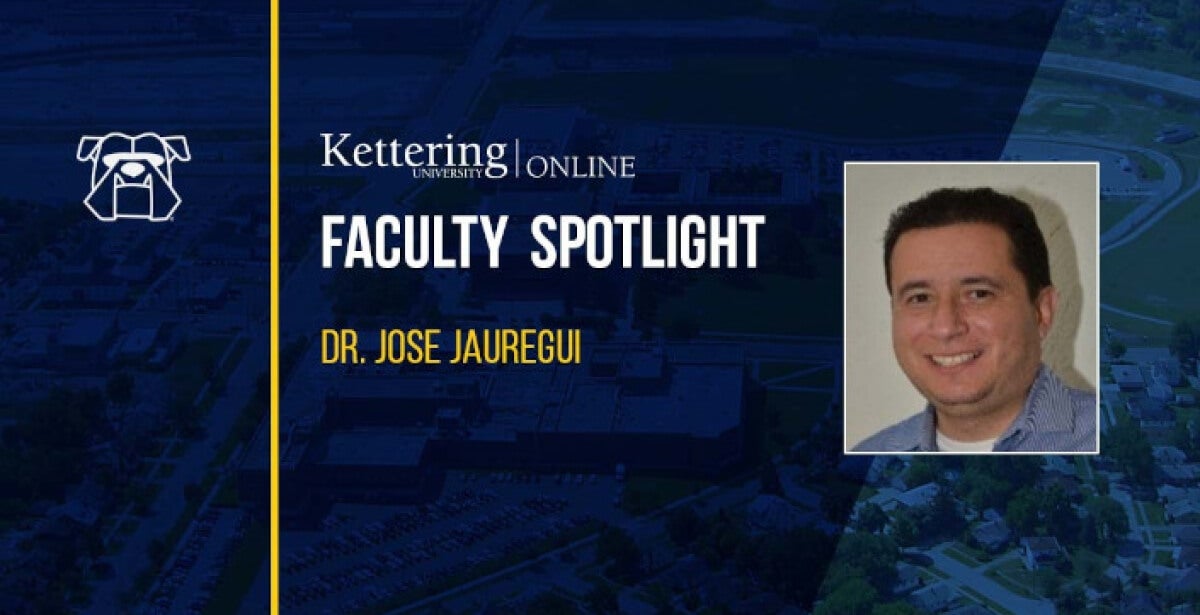
Faculty Spotlight: Dr. Jose Luis Jauregui
As Kettering University Online’s (KUO) Program Development Manager and Senior Instructional Designer, I have the pleasure of working with our Contributing Faculty members and Faculty Mentors, many of whom are subject matter experts for the courses they teach. Coming from a wide range of educational, career, and geographical backgrounds, KUO faculty unite in an effort to link transformative experiential education to rigorous academic standards with real-world applications for learning that last a lifetime.
This time, we are happy to shine the Faculty Spotlight on Dr. Jose Luis Jauregui. Dr. Jauregui teaches Lean Six Sigma, a course in KUO’s MS Lean Manufacturing Program; the only program of its kind in North America developed in partnership with General Motors.
Following are excerpts from our conversation:
JL: Dr. Jauregui, it’s good to chat with you. Thanks so much for taking the time.
JJ: My pleasure!
JL: The first question I always ask is, where did you grow up?
JJ: I spent most of my childhood in Guadalajara, Mexico, although I lived in Germany in 1999 and in Atlanta, GA from 2005 to 2007. Now I live in Mexicali, Mexico.
JL: Which degrees do you have and from where?
JJ: I hold a Bachelor in Industrial Engineering from Universidad de Guadalajara, an MBA from Instituto Tecnologico y de Estudios Superiores de Monterrey, and a PhD in Education - Educational Competences from Instituto Pedagogico y de Estudios Superiores de Jalisco.
JL: You are teaching the Lean Six Sigma course; can you provide a brief overview of Lean Six Sigma and its significance in the field of business process improvement?
JJ: Sure! Six Sigma is one of many continuous improvement methodologies developed by Motorola in the 80s and is based on the goal of reducing variations in the process of either manufacturing products or delivering services to 6 sigmas, or 3.4 defects per million. Six Sigma is also closely associated with the principles and practices of Define, Measure, Analyze, Improve, Control (DMAIC), Just in Time (JIT), and Lean Manufacturing which were developed by Toyota in the 70s. It might be helpful for me to quickly define each.
JL: Sure
JJ: Well, the DMAIC process has five steps to follow and, in each phase, we use different statistics and quantitative tools which allow us to identify the source of the variation and then implement improvement actions. Just in Time aims to minimize waste, reduce costs, and improve efficiencies by receiving or producing goods and services only when they are needed. Finally, Lean Manufacturing uses techniques related to reducing various kinds of waste and committing to continuous improvement.
- Read more about Lean Six Sigma: The Expensive Cost of Waste
JL: Can you highlight some of the industry sectors or job roles for which Lean Six Sigma principles and methodologies are particularly relevant and beneficial?
JJ: Any industry sector can benefit from applying Lean Six Sigma. I mean, there are no limitations as long as you have a problem related to variation in a process or wastes that cannot be identified or reduced. Something important to highlight is that in order to apply these methodologies, you should be using a problem for which you do not already have a solution.
JL: Have you encountered any interesting projects or initiatives showcasing the versatility of Lean Six Sigma in non-traditional sectors or industries?
JJ: Yes, a couple of years ago, I had a student that was in charge of the service workshop for a car agency in the city and she was not able to receive and service as many cars as per the standard. She then implemented a Lean Manufacturing project to identify the sources of waste, and after that, she was able to hit the goal of cars per day (10 minimum) and even increase the amount up to 12 cars per day. This is a successful case since it is an example of Lean Manufacturing principles and practices being applied to a service rather than a manufacturing process as is typical.
JL: What do you think are some of the key characteristics or qualities that make for a successful Lean Six Sigma practitioner or professional?
JJ: I would say some key characteristics are being knowledgeable in statistics, the ability to use programs such as Minitab, leadership, teamwork, and mathematical thinking.
JL: What specific skills and knowledge do you aim to instill in your learners through the Lean Six Sigma curriculum and how do these skills translate into real-world application?
JJ: One of the most important is having discipline since Lean and Six Sigma imply some specific steps that need to be followed in a strict manner.
JL: Speaking of teaching, what is your teaching philosophy?
JJ: My philosophy of teaching is to share my experience and knowledge with all my students. I do this by creating a trust-value atmosphere so the students can express themselves and create debate by hearing different insights. My role as a professor is to be a guide and mentor.
JL: Can you share insights or strategies you have found to be effective in fostering a collaborative and supportive online learning community among your students?
JJ: I think the discussions are the most valuable strategy for fostering collaborative and supportive online learning. This is where you can really interact with the students to read their thoughts/insights. You can also see how they reply to each other, and I can also add my own comments/experience to enrich the discussion.
JJ: What would you say about your Kettering learners?
JL: They are best in class. I had the opportunity to meet many of them from different industries. After the end of each term, I am always surprised and delighted by the amount of effort and dedication they put into their work – especially their final reports. Amazing!
JJ: What is the best advice a professor or mentor ever gave you?
JL: Listen to your learners... you are not the expert in all the subjects, but you are a guide for them.
JJ: That is such great advice!
JL: Are there any particular career achievements or highlights you would like to mention?
JJ: Sure! Thank you for asking! I authored a book titled: “Cultura Organizational, Una Experiencia de Vida”. (“Organizational Culture, A Life Experience”). Also, during my career, I received some recognition. In 2008, Tyco ACES (Six Sigma projects). I was also nominated in 2015 for HP’s Quality Award for support in Customer Service and, most recently, in 2015 for my excellent leadership in the HP separation.
JL: What do you enjoy doing in your spare time?
JJ: I enjoy going to the movies, cooking Mexican food, playing the piano, traveling, and playing golf.
JL: Thank you for creating space in your busy schedule to chat with us.
JJ: My pleasure!
KUO honors and appreciates Dr. Jauregui for his contributions and highly regarded work with students.
Take the Lean Six Sigma course with Dr. Jauregui as part of the Lean Principles for Healthcare certificate, available standalone or as part of a Master’s degree in Engineering Management, Lean Manufacturing, Operations Management, Supply Chain Management, or in the MBA program.

